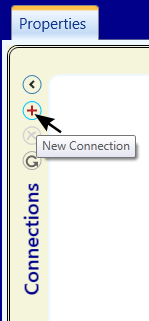 Create a New Connection
Create a New Connection
Flynet DataConnect offers the Full Experience for Microsoft SQL Server. This means you can create queries using a tile-based drag and drop interface.
To create a connection to a Microsoft SQL Server, make sure you are on the Connections tab. Then press the (+) icon at the very left hand side of the window.
Give your Connection a Name and Type
You then need to give your connection a name, and optionally a description.
From the Connection Type drop down, you select 'Microsoft SQL Server Connections'.

Enter your Microsoft SQL Server Host Name or IP, or Scan for Local Servers
You can either type in the host name or IP address of your Microsoft SQL Server, or you can press the drop-down arrow and search for a server on your local network.

Select your Database Authentication Method
You can authenticate against your Microsoft SQL Server by either using Windows or SQL Server authenticaiton.
If you select Windows Authentication, at design time it will attempt to connect to your database using the user of the Flynet Runtime Service (which by default is Local System). When you publish your web service, the web service will attempt to connect to your database using the IIS Web Server Application Pool user. By default neither of these users have access to your database and you will need to set it up.
If you select SQL Authentication, you will be prompted to enter an SQL Server username and password. (This is not a Windows username and password.)

Testing the Connection
Once you have filled in all the details, you need to press the Test Connection button. This will use the information you have given and attempt to connect to the Microsoft SQL Server.
If the connection fails, you are presented with the error returned by the Microsoft database connector. Common problems are incorrect hostname, username and password or the user given does not have access to the database.

Select the Database or Catalog
Once the connection has passed the test, you are presented with a list of databases or catalogs available to you.
If you do not see anything listed, it is most likely because the user you have specified does not have the necessary Microsoft SQL Server rights. The user must have the SQL Server role 'public' and have the role 'db_datareader' on the databases you wish to access.

Save your Connection
Once you have selected your catalog or database, you must press the Save button. When press Save, DataConnect will fetch a list of the tables, views and stored procedures in your database and display them at the bottom of your connection.
If your database is slower or is very large, this may take some time, you may need to press the refresh icon found at the very left hand side below the (+) 'add new' icon.

